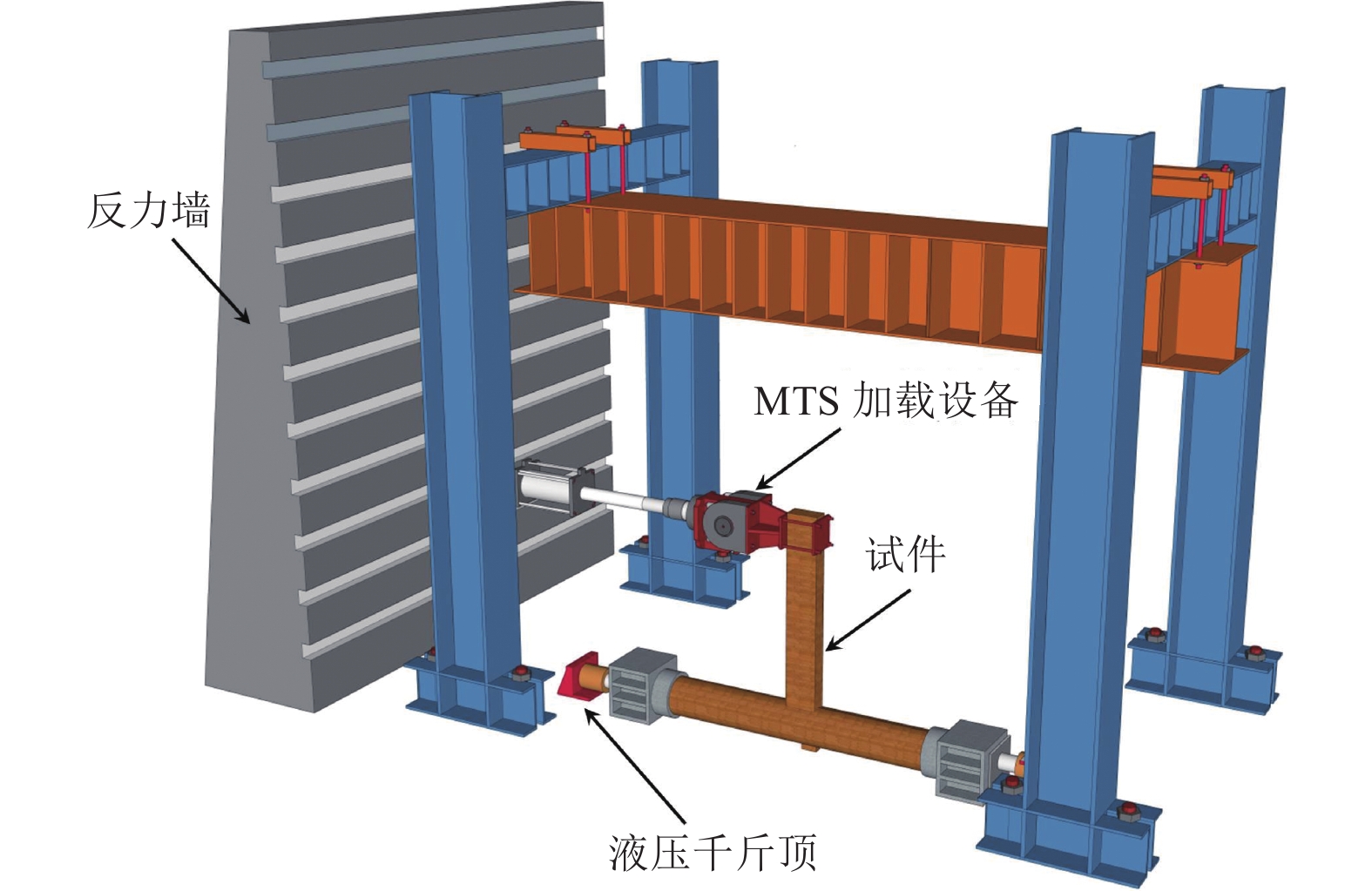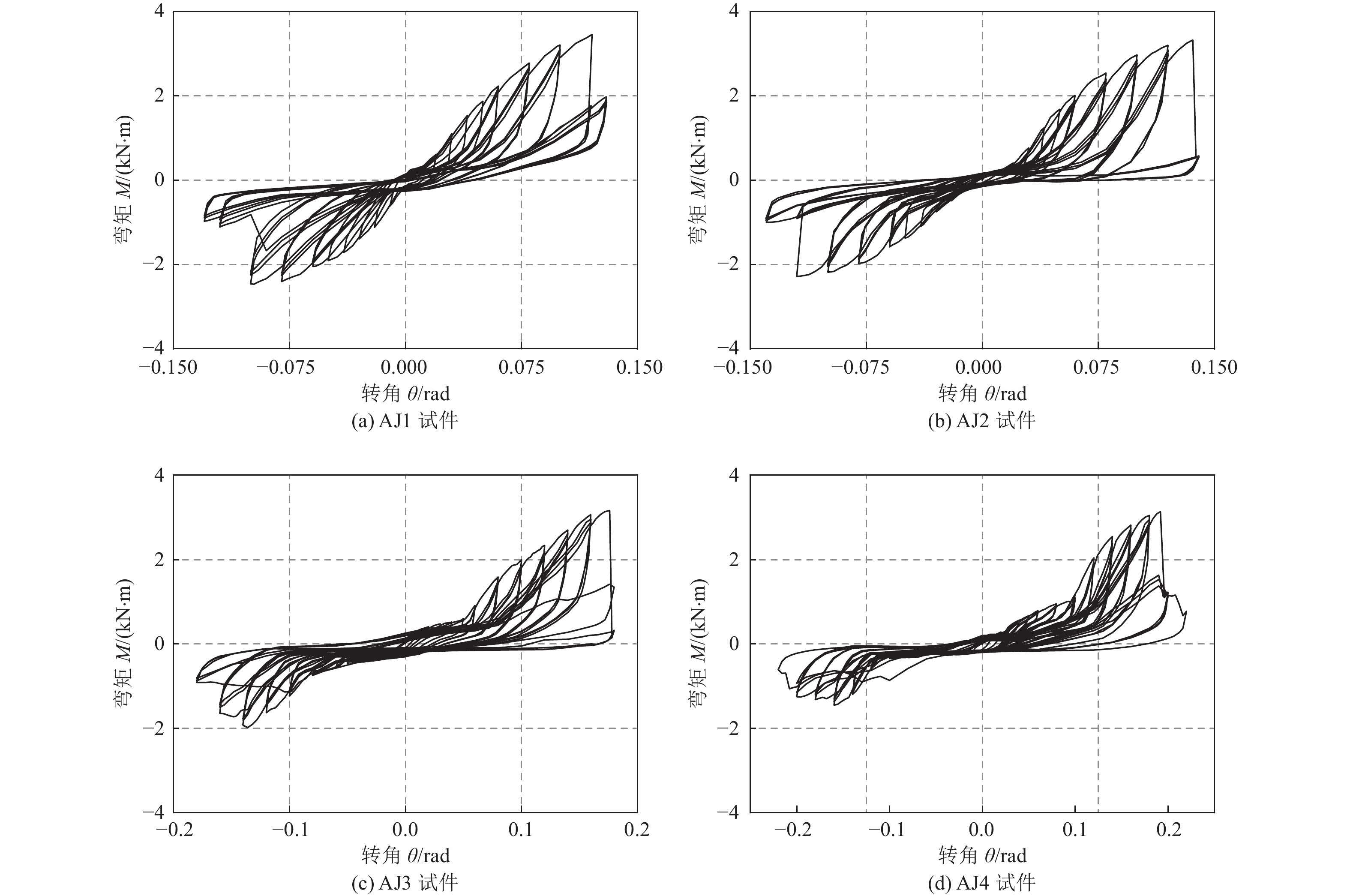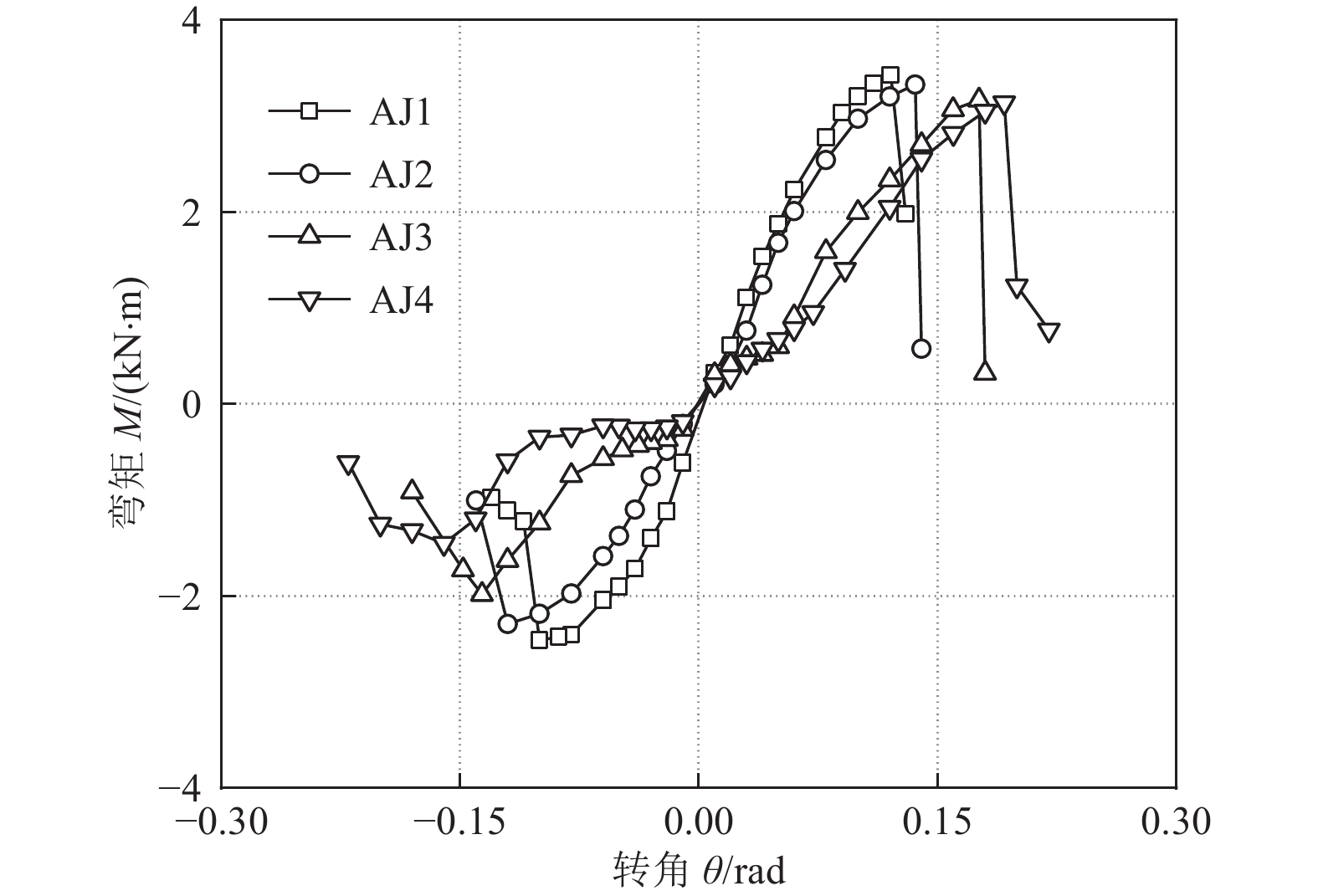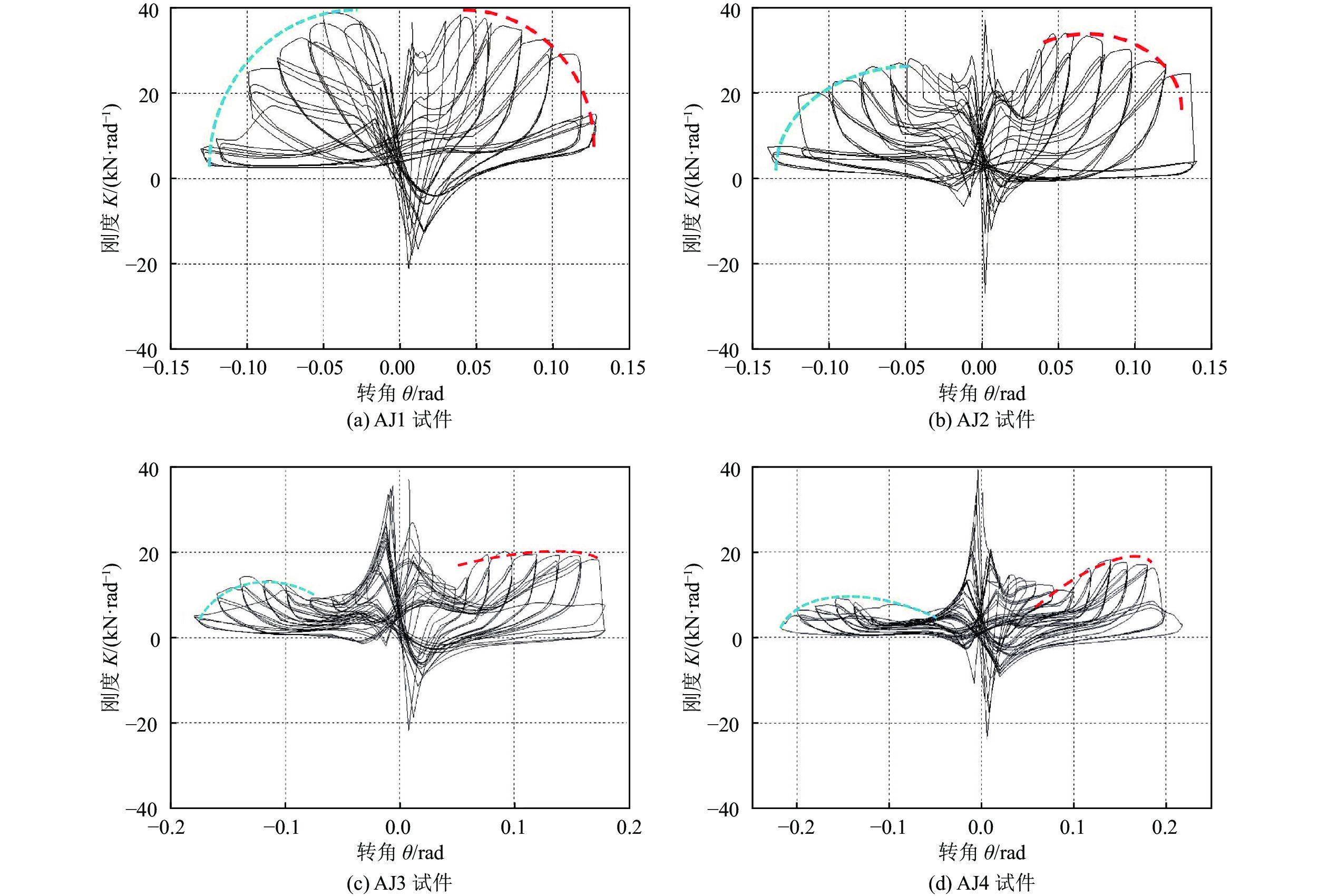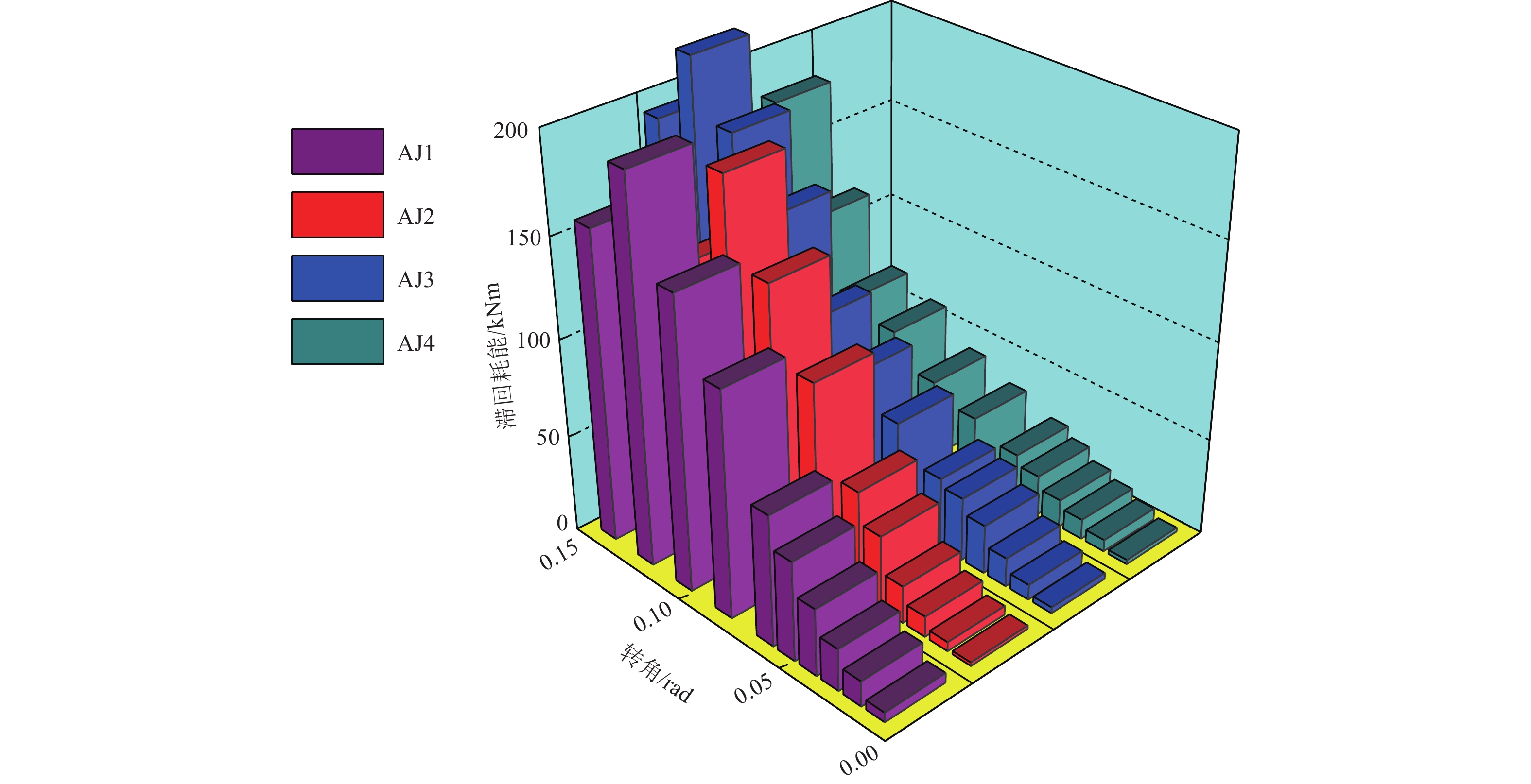Experimental Study on Seismic Performance of Irregular Mortise-and-Tenon Joints in Damaged Ancient Architectural Wood Structures
-
摘要: 为研究残损古建筑木结构不对称榫卯节点的力学特性,共设计4个足尺古木结构榫卯节点,包括1个连接完好及3个存在不同松动程度的不对称榫卯节点,通过拟静力试验获得其弯矩-转角滞回曲线,对其滞回特性、骨架曲线、耗能能力及刚度退化规律等进行分析。结果表明,残损节点滞回曲线呈反“Z”形,捏缩效应显著;存在松动的不对称榫卯节点峰值弯矩及转动刚度均小于连接紧密的节点试件,而极限转角大于连接紧密的节点试件。随着节点松动程度的不断增大,各试件峰值弯矩、转动刚度峰值及滞回耗能逐渐降低。控制位移不变时,连接紧密完好节点的滞回耗能及刚度明显高于松动节点;各不对称榫卯节点正、负向刚度不等。同时,本研究获得了不同松动程度下节点的正、负向刚度理论公式,为工程加固修缮提供理论依据。Abstract: To investigate the mechanical properties of asymmetric mortise-tenon joints in ancient wooden structures, four full-scale mortise-tenon joints were designed. This included one intact joint and three joints with varying levels of damage. Moment-rotation hysteretic curves were obtained for the mortise and tenon joints under low cyclic reversed loading tests. The hysteretic characteristics, skeleton curve, energy dissipation capacity, and stiffness degradation were analyzed. The experimental results indicate that the shape of the hysteretic curve changes from an "S" shape to an inverted "Z" shape as the level of damage increases, with the pinching effect becoming more pronounced. The ultimate bending moment and rotational stiffness of the damaged mortise and tenon joints are less than those of the intact joints, while the ultimate rotation capacity of the damaged joints is greater. As the looseness of the joints increases, the ultimate bending moment, peak rotational stiffness, and hysteretic energy decrease gradually. Under the same load displacement level, the hysteretic energy and stiffness of the intact joint are significantly higher than those of the damaged joints. A positive and negative stiffness theory formula was derived, providing a theoretical basis for engineering applications.
-
表 1 木材力学性能指标
Table 1. The mechanical performance index of wood
木材种类 顺纹弹性
模量/MPa径向弹性
模量/MPa弦向弹性
模量/MPa樟子松 3550 210 154 表 2 各试件榫头尺寸
Table 2. The mortise size of specimen
试件
编号榫头削减
尺寸/mm削减后榫头I
尺寸/mm削减后榫头II
尺寸/mm松动
程度DAJ1 0 240 120 — AJ2 12 228 108 5.0% AJ3 24 216 96 10.0% AJ4 36 204 84 15.0% 表 3 各节点滞回耗能
Table 3. Hysteretic energy of mortise and tenon joint
试件 滞回耗能/(kN·m) 5 mm 10 mm 15 mm 20 mm 25 mm 30 mm 40 mm 50 mm 60 mm 70 mm 80 mm 90 mm 100 mm TJ1 5.00 13.06 21.77 34.53 51.08 67.19 115.39 158.97 214.12 158.53 — — — TJ2 3.15 7.92 14.89 25.31 38.18 54.16 96.54 133.81 175.43 128.02 — — — TJ4 1.85 4.75 10.79 19.22 33.01 36.89 53.53 68.26 85.34 103.11 130.10 169.65 149.77 TJ6 1.18 4.09 8.37 14.36 20.75 25.98 33.61 41.57 58.10 65.99 99.27 150.67 120.09 表 4 各节点刚度值
Table 4. Unloading stiffness values of mortise and tenon joint under different degree of looseness
转角/rad 刚度值K/(kN·mm−1) AJ1 AJ2 AJ3 AJ4 正向 负向 正向 负向 正向 负向 正向 负向 0.06 0.238 0.161 0.230 0.202 0.147 0.064 0.114 0.042 0.08 0.218 0.123 0.207 0.119 0.144 0.060 0.108 0.039 0.10 0.199 0.102 0.203 0.114 0.142 0.059 0.104 0.034 0.12 0.182 0.037 0.202 0.108 0.139 0.057 0.103 0.027 0.14 0.092 0.030 0.038 0.040 0.138 0.049 0.087 0.027 0.16 — — — — 0.110 0.046 0.072 0.024 0.18 — — — — 0.097 0.029 0.065 0.023 0.20 — — — — 0.075 0.022 0.063 0.017 -
高永林,陶忠,叶燎原等,2016. 传统穿斗木结构榫卯节点附加黏弹性阻尼器振动台试验. 土木工程学报,49(2):59−68.Gao Y. L., Tao Z., Ye L. Y., et al., 2016. Shaking table tests of mortise-tenon joints of a traditional Chuan-Dou wood structure attached with viscoelastic dampers. China Civil Engineering Journal, 49(2): 59−68. (in Chinese) 李义柱,曹双寅,2017. 不同拔榫程度的古建筑燕尾榫节点受力性能分析. 四川建筑科学研究,43(3):1−4. doi: 10.3969/j.issn.1008-1933.2017.03.001Li Y. Z., Cao S. Y., 2017. Mechanical behavior on dovetail mortise-tenon joints with different pulling-out in ancient buildings. Sichuan Building Science, 43(3): 1−4. (in Chinese) doi: 10.3969/j.issn.1008-1933.2017.03.001 李钊,王志涛,郭小东,2022. 残损古建筑木结构力学性能相关研究进展与展望. 林产工业,59(12):39−46.Li Z., Wang Z. T., Guo X. D., 2022. Research progress and prospect on mechanical properties of damaged ancient timber structures. China Forest Products Industry, 59(12): 39−46. (in Chinese) 梁思成,1986. 为什么研究中国建筑. 建筑学报,33(9):3−7.Liang S. C., 1986. Significance of research on Chinese architecture. Architectural Journal, 33(9): 3−7. (in Chinese) 潘毅,安仁兵,王晓玥等,2020. 古建筑木结构透榫节点力学模型研究. 土木工程学报,53(4):61−70,82.Pan Y., An R. B., Wang X Y., et al., 2020. Study on mechanical model of through-tenon joints in ancient timber structures. China Civil Engineering Journal, 53(4): 61−70,82. (in Chinese) 秦术杰,杨娜,胡浩然等,2018. 残损明清古建筑木结构动力特性研究. 建筑结构学报,39(10):130−137.Qin S. J., Yang N., Hu H. R., et al., 2018. Study on dynamic characteristics of a damaged ancient timber structure of Ming-Qing Dynasty. Journal of Building Structures, 39(10): 130−137. (in Chinese) 商博渊,2010. 台湾传统木构造「减榫」力学行为与模拟生物劣化之研究. 台南,中国:国立成功大学.Shang B. Y. ,2010. Mechanical performance of Taiwanese traditional “right-angled-notch-tenon” timber connections-by reviewing the effects of simulated termite infestation. Tainan,China:National Cheng Kung University. (in Chinese) 沈银澜,周敬轩,王利辉等,2021. 北方村落木结构民居榫卯节点抗震性能试验研究. 震灾防御技术,16(1):165−175.Shen Y. L., Zhou J. X., Wang L. H., et al., 2021. Experimental study on seismic performance of mortise-tenon joints of traditional wood residences in North China villages. Technology for Earthquake Disaster Prevention, 16(1): 165−175. (in Chinese) 谢启芳,郑培君,向伟等,2014. 残损古建筑木结构单向直榫榫卯节点抗震性能试验研究. 建筑结构学报,35(11):143−150.Xie Q. F., Zheng P. J., Xiang W., et al., 2014. Experimental study on seismic behavior of damaged straight mortise-tenon joints of ancient timber buildings. Journal of Building Structures, 35(11): 143−150. (in Chinese) 谢启芳,杜彬,李双等. 2015. 残损古建筑木结构燕尾榫节点抗震性能试验研究. 振动与冲击, 34 (4):165−170,210.Xie Q. F. , Du B. , Li S. , et al. , 2015. Tests for aseismic behaviors of damaged dovetail mortise-tenon joints of ancient timber buildings. Journal of Vibration and Shock, 34 (4): 165−170, 210. (in Chinese) 薛建阳,李义柱,夏海伦等,2016. 不同松动程度的古建筑燕尾榫节点抗震性能试验研究. 建筑结构学报,37(4):73−79.Xue J. Y., Li Y. Z., Xia H. L., et al., 2016. Experimental study on seismic performance of dovetail joints with different loose degrees in ancient buildings. Journal of Building Structures, 37(4): 73−79. (in Chinese) 薛建阳,董金爽,夏海伦等,2018. 不同松动程度下古建筑木结构透榫节点弯矩-转角关系分析. 西安建筑科技大学学报(自然科学版),50(5):638−644.Xue J. Y., Dong J. S., Xia H. L., et al., 2018. Moment-rotation relationship of through-tenon joints under different degree of looseness in ancient wooden buildings. Journal of Xi'an University of Architecture & Technology (Natural Science Edition), 50(5): 638−644. (in Chinese) 薛建阳,白福玉,张锡成等,2019. 古建筑木结构地震损伤分析及抗侧刚度识别. 湖南大学学报(自然科学版),46(1):55−64.Xue J. Y., Bai F. Y., Zhang X. C., et al., 2019. Seismic damage analysis and lateral stiffness identification for ancient wooden structures. Journal of Hunan University (Natural Sciences), 46(1): 55−64. (in Chinese) 姚佩歆,2011. 木结构古建筑特殊构件雀替、生起和侧脚的受力分析. 西安:西安建筑科技大学.Yao P. X. ,2010. Study on the force analysis of Chinese historical timber buildings’ special components with Que Ti,CeJiao and ShengQi. Xi’an:Xi’an University of Architecture and Technology. (in Chinese) 张锡成,2010. 中国木结构古建筑的概念设计思想及抗滑移倒塌性能研究. 西安:西安建筑科技大学.Zhang X. C. ,2010. Research on the conceptual-design thoughts and sliding collapse performance of Chinese ancient timber-frame buildings. Xi’an:Xi’an University of Architecture and Technology. (in Chinese) 张锡成,代武强,薛建阳. 2018. 带空隙透榫节点弯矩-转角关系理论分析. 湖南大学学报(自然科学版), 45 (5):125−133.Zhang X. C. , Dai W. Q. , Xue J. Y. , 2018. Theoretical analysis on moment-rotation relationship of through-tenon joint with gap. Journal of Hunan University (Natural Sciences), 45 (5): 125−133. (in Chinese) Chang W. S., Hsu M. F., Komatsu K., 2006. Rotational performance of traditional Nuki joints with gap I: theory and verification. Journal of Wood Science, 52(1): 58−62. doi: 10.1007/s10086-005-0734-7 Chang W. S., Hsu M. F., 2007. Rotational performance of traditional Nuki joints with gap II: the behavior of butted Nuki joint and its comparison with continuous Nuki joint. Journal of Wood Science, 53(5): 401−407. doi: 10.1007/s10086-007-0880-1 King W. S., Yen J. Y. R., Yen Y. N. A., 1996. Joint characteristics of traditional Chinese wooden frames. Engineering Structures, 18(8): 635−644. doi: 10.1016/0141-0296(96)00203-9 Ogawa K, Sasaki Y, Yamasaki M., 2016. Theoretical estimation of the mechanical performance of traditional mortise-tenon joint involving a gap. Journal of Wood Science, 62(3): 242−250. doi: 10.1007/s10086-016-1544-9 Yang Q. S., Gao C., Wang J., et al., 2020a. Probability distribution of gaps between tenon and mortise of traditional timber structures. European Journal of Wood and Wood Products, 78(1): 27−39. doi: 10.1007/s00107-019-01472-1 Yang Q. S., Yu P., Law S. S., 2020b. Load resisting mechanism of the mortise-tenon connection with gaps under in-plane forces and moments. Engineering Structures, 219: 110755. doi: 10.1016/j.engstruct.2020.110755 -



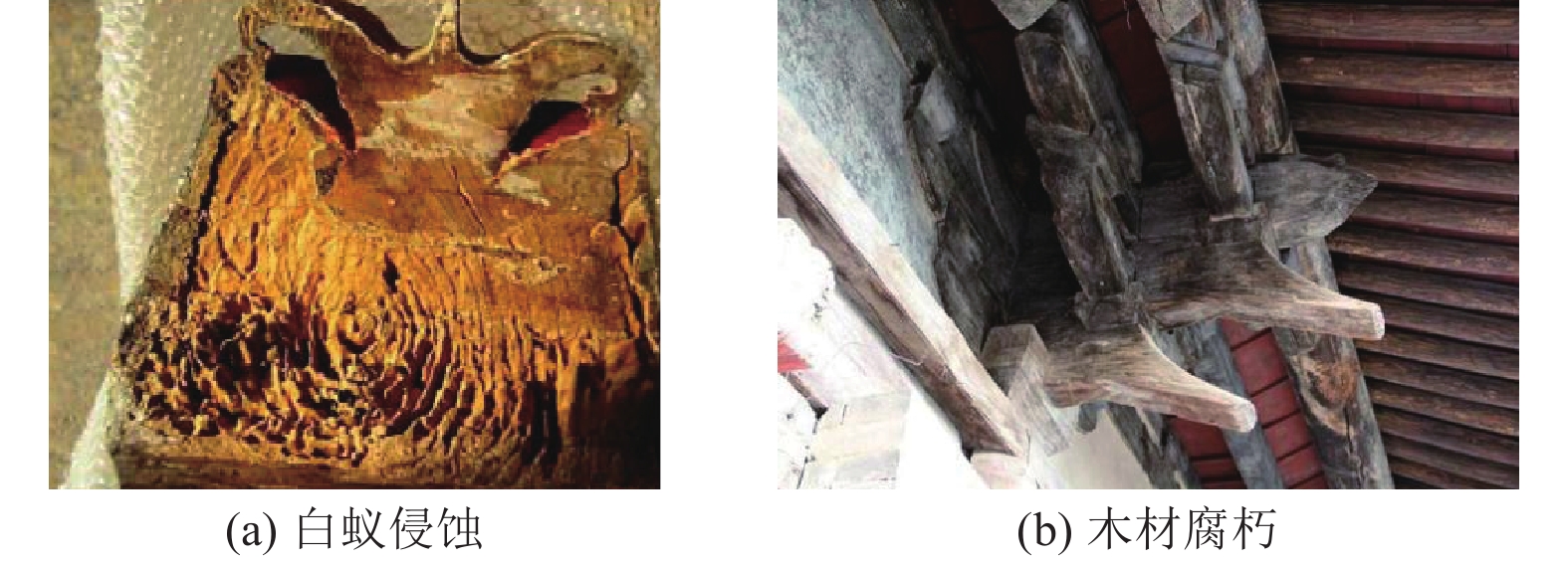
 下载:
下载:

